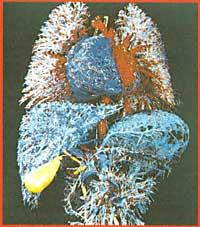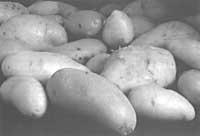Liver: body laboratory
1987/12/01 Agirre, Jabier - Medikua eta OEEko kidea Iturria: Elhuyar aldizkaria
The human liver has been on many occasions compared to a factory and not without reason. In this imposing factory of our body, skilled and highly skilled workers work constantly all the products that come from different organs (proteins, fats and glucides in particular, but also alcohol, medicines, toxic, etc.). also) with the intention of metabolizing different topics: one for the general energy maintenance of the body, another for the reservation and, finally, a third group, residues and toxic substances for its elimination. Much importance has always been given to the liver. For a long time it was accepted as the main place of life and along with the heart was also the origin of blood. Due to the complexity and essential of its functioning, the liver has been the human organ that has finally approached the new techniques of transplantation.

The liver, as a differentiated and singular organ, is only seen in vertebrates. For example, shell ones only have a small viscera and their function is not yet well known. After millions of years of evolution, this organ of just 1500 grams of weight is more effective than any other part of the body, since it currently performs more than five hundred different functions and not one after another, but at the same time. Let's see, then, the main tasks.
Synthesis of blood plasmas (albumin, globulins, etc. ). ), produces the workers' own troops dedicated to the repair of the blood vessels, participates also in the coagulation or coagulation of the blood (through prothrombin, among other factors). It produces proteins for tissues from amino acids from the metabolism of proteins, transforms them every time into amino acids.
One of the functions that makes the liver irreplaceable is to be a glucoregulator. This function allows maintaining blood glucose levels in normal measurements. How does the liver work? Accumulating excess glucose in the form of glycogen. Then, when glucose is needed, it is released from the accumulated glycogen and glucose form from the amino acids. In the clinical tests performed with rats it has been observed that when they are not given food, blood glucose (blood glucose level) is maintained for a week without any type of alteration. However, glucose deposits in the liver appear empty when twenty hours have passed. But the third day the deposits are refilled because the fat accumulated in the liver becomes glucose.
As has been seen, the liver works according to the needs of the body, transforming the subjects and transforming them later again. But the liver is not like this. It converts glucose surplus into fat, which according to their beliefs, and for the displeasure of many, are distributed by the body (are the cursed kilos that scare us). On the other hand, it metabolizes fats, synthesizes cholesterol, expels dead cells destroyed from the body, the main processes of deoxygenation go on their own, etc.
But the advantages of the liver do not end like this. Although any body organ responds painfully to an attack, injury, or poisoning, in the case of the liver, fortunately, it is not. If not, the brain would constantly receive signals. The work of the liver and self-equation are silent and continuous. And not only that: if a rat is extracted three-quarters of the liver, the remaining quarter begins immediately to run, coming to regain almost all its power before. However, the liver has other ways to send the alarm signal. In this way, the degree of alcohol is excessive and prolonged, the most complicated healing of the wounds or the tendency to hemorrhages.
The reason of existence of the liver is the protection of other organs of the body. For example, the alcohol-filled liver, which is hung, puts the person in danger of any pavement, even if the liver has not suffered consequences. That is the revenge that the liver has prepared us after many years vending excesses.

Gai honi buruzko eduki gehiago
Elhuyarrek garatutako teknologia





